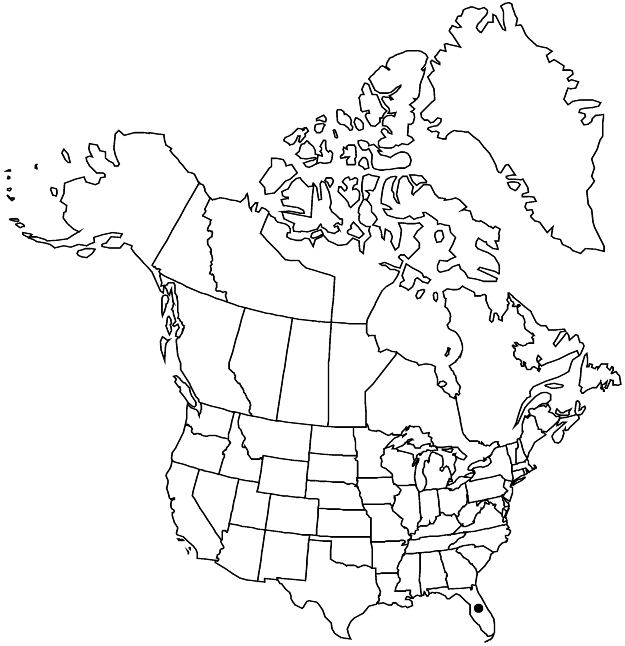Difference between revisions of "Rubus niveus"
Rubo, 9, fig. 3. 1813.
FNA>Volume Importer |
imported>Volume Importer |
||
| (3 intermediate revisions by 2 users not shown) | |||
| Line 28: | Line 28: | ||
|elevation=0–30 m | |elevation=0–30 m | ||
|distribution=Fla.;Africa;introduced also in Central America;South America;Pacific Islands (Hawaii). | |distribution=Fla.;Africa;introduced also in Central America;South America;Pacific Islands (Hawaii). | ||
| + | |introduced=true | ||
|discussion=<p><i>Rubus niveus</i> is distinguished from other raspberries by its pinnately compound leaves with 5–7 leaflets, ovate to broadly ovate terminal leaflet, leaflets with prickles on the midvein, and pink to magenta, broadly obovate to orbiculate petals. The species was introduced into southern Florida around 1949 from seeds obtained in Kenya and quickly became popular for its fruits, which are edible fresh or frozen and are often used in preserves, pies, and tarts (J. F. Morton 1987).</p> | |discussion=<p><i>Rubus niveus</i> is distinguished from other raspberries by its pinnately compound leaves with 5–7 leaflets, ovate to broadly ovate terminal leaflet, leaflets with prickles on the midvein, and pink to magenta, broadly obovate to orbiculate petals. The species was introduced into southern Florida around 1949 from seeds obtained in Kenya and quickly became popular for its fruits, which are edible fresh or frozen and are often used in preserves, pies, and tarts (J. F. Morton 1987).</p> | ||
|tables= | |tables= | ||
| Line 37: | Line 38: | ||
-->{{#Taxon: | -->{{#Taxon: | ||
name=Rubus niveus | name=Rubus niveus | ||
| − | |||
|authority=Thunberg | |authority=Thunberg | ||
|rank=species | |rank=species | ||
| Line 53: | Line 53: | ||
|publication year=1813 | |publication year=1813 | ||
|special status=Introduced | |special status=Introduced | ||
| − | |source xml=https:// | + | |source xml=https://bitbucket.org/aafc-mbb/fna-data-curation/src/2e0870ddd59836b60bcf96646a41e87ea5a5943a/coarse_grained_fna_xml/V9/V9_62.xml |
|subfamily=Rosaceae subfam. Rosoideae | |subfamily=Rosaceae subfam. Rosoideae | ||
|tribe=Rosaceae tribe Rubeae | |tribe=Rosaceae tribe Rubeae | ||
Latest revision as of 22:58, 5 November 2020
Shrubs, 10–30 dm, armed. Stems biennial, erect to arching, often scrambling, sparsely hairy, glabrescent, eglandular, strongly pruinose; prickles sparsely to moderately dense, hooked to reflexed, stout, 3–9 mm, broad-based. Leaves deciduous, pinnately compound; stipules linear-lanceolate, 4–8 mm; leaflets (3–)5–7(–9), terminal ovate to broadly ovate, 4–6.7 × (2.4–)3.4–5.4 cm, base shallowly cordate, sometimes shallowly 3-lobed, margins coarsely serrate to doubly serrate, apex acute to short-acuminate, abaxial surfaces with scattered, reflexed, broad-based prickles on midveins, densely white-tomentose, eglandular. Inflorescences terminal and axillary, 1–11-flowered, cymiform. Pedicels: prickles absent or sparse, erect to reflexed, pubescent, eglandular. Flowers bisexual; petals pink to magenta, broadly obovate to orbiculate, 4 mm; filaments laminar; ovaries densely hairy. Fruits purple-black, hemispheric to globose, 0.5–1.5 cm; drupelets 50–75, coherent, separating from torus. 2n = 14.
Phenology: Flowering year-round.
Habitat: Disturbed sites adjacent to tropical or subtropical woodlands
Elevation: 0–30 m
Distribution

Introduced; Fla., Africa, introduced also in Central America, South America, Pacific Islands (Hawaii).
Discussion
Rubus niveus is distinguished from other raspberries by its pinnately compound leaves with 5–7 leaflets, ovate to broadly ovate terminal leaflet, leaflets with prickles on the midvein, and pink to magenta, broadly obovate to orbiculate petals. The species was introduced into southern Florida around 1949 from seeds obtained in Kenya and quickly became popular for its fruits, which are edible fresh or frozen and are often used in preserves, pies, and tarts (J. F. Morton 1987).
Selected References
None.